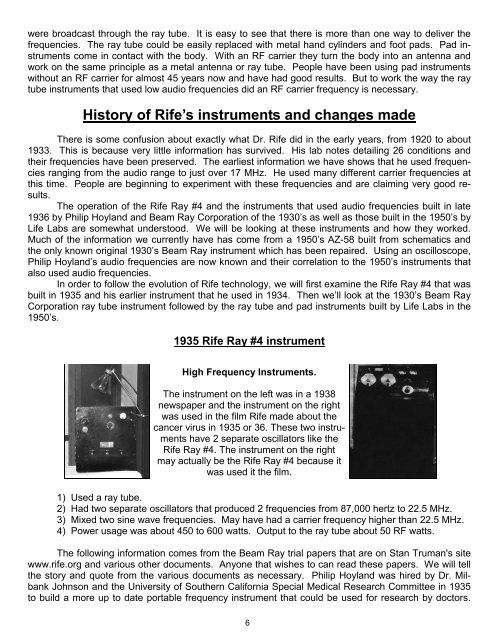A History Of Rife's Instruments And Frequencies.pub
A History Of Rife's Instruments And Frequencies.pub
A History Of Rife's Instruments And Frequencies.pub
Create successful ePaper yourself
Turn your PDF publications into a flip-book with our unique Google optimized e-Paper software.
were broadcast through the ray tube. It is easy to see that there is more than one way to deliver the<br />
frequencies. The ray tube could be easily replaced with metal hand cylinders and foot pads. Pad instruments<br />
come in contact with the body. With an RF carrier they turn the body into an antenna and<br />
work on the same principle as a metal antenna or ray tube. People have been using pad instruments<br />
without an RF carrier for almost 45 years now and have had good results. But to work the way the ray<br />
tube instruments that used low audio frequencies did an RF carrier frequency is necessary.<br />
<strong>History</strong> of Rife’s instruments and changes made<br />
There is some confusion about exactly what Dr. Rife did in the early years, from 1920 to about<br />
1933. This is because very little information has survived. His lab notes detailing 26 conditions and<br />
their frequencies have been preserved. The earliest information we have shows that he used frequencies<br />
ranging from the audio range to just over 17 MHz. He used many different carrier frequencies at<br />
this time. People are beginning to experiment with these frequencies and are claiming very good results.<br />
The operation of the Rife Ray #4 and the instruments that used audio frequencies built in late<br />
1936 by Philip Hoyland and Beam Ray Corporation of the 1930’s as well as those built in the 1950’s by<br />
Life Labs are somewhat understood. We will be looking at these instruments and how they worked.<br />
Much of the information we currently have has come from a 1950’s AZ-58 built from schematics and<br />
the only known original 1930’s Beam Ray instrument which has been repaired. Using an oscilloscope,<br />
Philip Hoyland’s audio frequencies are now known and their correlation to the 1950’s instruments that<br />
also used audio frequencies.<br />
In order to follow the evolution of Rife technology, we will first examine the Rife Ray #4 that was<br />
built in 1935 and his earlier instrument that he used in 1934. Then we’ll look at the 1930’s Beam Ray<br />
Corporation ray tube instrument followed by the ray tube and pad instruments built by Life Labs in the<br />
1950’s.<br />
1935 Rife Ray #4 instrument<br />
High Frequency <strong>Instruments</strong>.<br />
The instrument on the left was in a 1938<br />
newspaper and the instrument on the right<br />
was used in the film Rife made about the<br />
cancer virus in 1935 or 36. These two instruments<br />
have 2 separate oscillators like the<br />
Rife Ray #4. The instrument on the right<br />
may actually be the Rife Ray #4 because it<br />
was used it the film.<br />
1) Used a ray tube.<br />
2) Had two separate oscillators that produced 2 frequencies from 87,000 hertz to 22.5 MHz.<br />
3) Mixed two sine wave frequencies. May have had a carrier frequency higher than 22.5 MHz.<br />
4) Power usage was about 450 to 600 watts. Output to the ray tube about 50 RF watts.<br />
The following information comes from the Beam Ray trial papers that are on Stan Truman's site<br />
www.rife.org and various other documents. Anyone that wishes to can read these papers. We will tell<br />
the story and quote from the various documents as necessary. Philip Hoyland was hired by Dr. Milbank<br />
Johnson and the University of Southern California Special Medical Research Committee in 1935<br />
to build a more up to date portable frequency instrument that could be used for research by doctors.<br />
6




